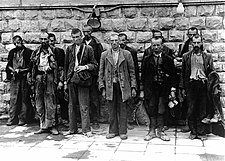
Back معسكر اعتقال ماوتهاوزن Arabic Mauthauzen həbs düşərgəsi Azerbaijani Маутхаузен (концлагер) Bulgarian Kamp-bac'h Mauthausen Breton Koncentracijski logor Mauthausen BS Mauthausen-Gusen Catalan Koncentrační tábor Mauthausen Czech Mauthausen-Gusen koncentrationslejr Danish KZ Mauthausen German Στρατόπεδο συγκέντρωσης Μαουτχάουζεν-Γκούζεν Greek
| Mauthausen | |
|---|---|
| Nazi concentration camp | |
 | |
| Location | Mauthausen, Upper Austria |
| Commandant | Albert Sauer Franz Ziereis |
| Operational | 1938 – May 1945 |
| Inmates | Political prisoners, Jews, Soviet POWs |
| Number of inmates | 190,000[1] |
| Killed | More than 90,000[1] |
| Liberated by | United States Army, 3–6 May 1945 |


Mauthausen was a German Nazi concentration camp on a hill above the market town of Mauthausen (roughly 20 kilometres (12 mi) east of Linz), Upper Austria. It was the main camp of a group with nearly 100 further subcamps located throughout Austria and southern Germany.[2][3] The three Gusen concentration camps in and around the village of St. Georgen/Gusen, just a few kilometres from Mauthausen, held a significant proportion of prisoners within the camp complex, at times exceeding the number of prisoners at the Mauthausen main camp.
The Mauthausen main camp operated from 8 August 1938, several months after the German annexation of Austria, to 5 May 1945, when it was liberated by the United States Army. Starting with the camp at Mauthausen, the number of subcamps expanded over time. In January 1945, the camps contained roughly 85,000 inmates.
As at other Nazi concentration camps, the inmates at Mauthausen and its subcamps were forced to work as slave labour, under conditions that caused many deaths. Mauthausen and its subcamps included quarries, munitions factories, mines, arms factories and plants assembling Me 262 fighter aircraft.[4][5] The conditions at Mauthausen were even more severe than at most other Nazi concentration camps. Half of the 190,000 inmates died at Mauthausen or its subcamps.
Mauthausen was one of the first massive concentration camp complexes in Nazi Germany, and the last to be liberated by the Allies. The Mauthausen main camp is now a museum.
- ^ a b Freund & Kranebitter (2016), p. 56.
- ^ Dobosiewicz (2000), pp. 191–202.
- ^ Bischof & Pelinka (1996), pp. 185–190.
- ^ Haunschmied, Mills & Witzany-Durda (2008), pp. 172–175.
- ^ Walden (2000).
